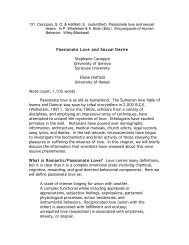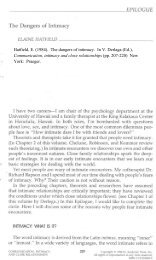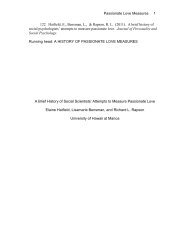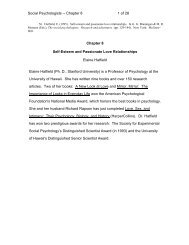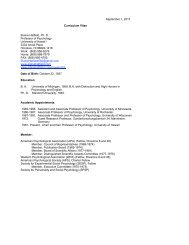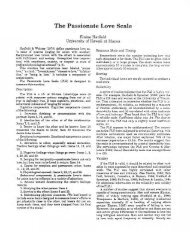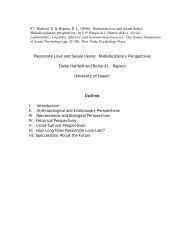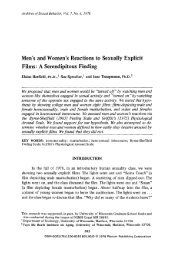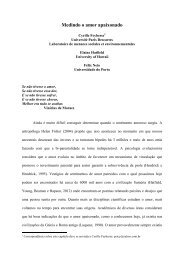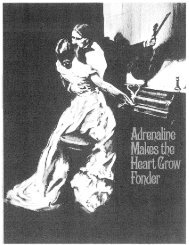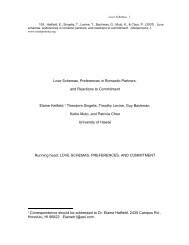4Today, most anthropologists argue that passionate love is a universal experience,transcending culture <strong>and</strong> time (Buss, 1994; <strong>Hatfield</strong> & Rapson, 1996; Jankowiak, 1995;Tooby & Cosmides, 1992).Jankowiak <strong>and</strong> Fischer (1992) drew a sharp distinction between “romanticpassion” <strong>and</strong> “simple lust.” They proposed that both passion <strong>and</strong> lust are universalfeelings. Drawing on a sampling of tribal societies from the St<strong>and</strong>ard Cross-CulturalSample, they found that in almost all of these far flung societies, young lovers talkedabout passionate love, recounted tales of love, sang love songs, <strong>and</strong> spoke of the longings<strong>and</strong> anguish of infatuation. When passionate affections clashed with parents’ or elders’wishes, young couples often eloped.Social anthropologists have explored folk conceptions of love in such diversecultures as The People’s Republic of China, Indonesia, Turkey, Nigeria, Trinidad,Morocco, <strong>and</strong> the Fulbe of North Cameroun, the Mangrove (an aboriginal Australiancommunity), the Mangaia in the Cook Isl<strong>and</strong>s, Palau in Micronesia, <strong>and</strong> the Taita ofKenya (see Jankowiak, 1995, for a review of this research.) In all these studies, people’sconceptions of passionate love appear to be surprisingly similar.Anthropologists have also been interested in the kinds of societies in which ourprimate ancestors lived. Sommer (1993), for example, asked a challenging question: Didour ancient Homo sapiens ancestors live in monogamous, polygamous, poly<strong>and</strong>rous, orpolygyn<strong>and</strong>rous communities? (In monogamy, a man <strong>and</strong> woman marry—usually for alifetime. In polygamy, one man may possess many wives; in poly<strong>and</strong>ry, one woman maytake several husb<strong>and</strong>s. In polygyn<strong>and</strong>ry, or “promiscuous” mating, men <strong>and</strong> women maymate at will.)
5After observing many kinds of primates, Sommer discovered that it is easy topredict what sort of sexual mating arrangements a primate species will adopt. All heneeded to know were four facts: (1) in that species, who is bigger—the males or thefemales? (2) how much do the males’ testes weigh? (3) do females have sexualswellings (which signal sexual receptivity <strong>and</strong> fertility)? <strong>and</strong> (4) how long does sexualintercourse last? (The scientists found, for example, that in monogamous species suchas gibbons, males <strong>and</strong> females are generally about the same size. In polygynousspecies such as orangutans (where successful males must physically dominate theirrivals), males are much larger than their mates.When Sommer classified Homo sapiens on these four characteristics, hiscalculations led him to conclude that although our human forebears may have beenmonogamous, the odds are that they were polygynous. 1There is no chance that theywere either poly<strong>and</strong>rous or polygyn<strong>and</strong>rous.What about our more immediate ancestors? How did they live? On the basis ofher calculations, Fisher (1989) concluded that throughout the world, although (intheory) most societies are polygynous, in fact, the overwhelming majority of marriedmen <strong>and</strong> women are actually in monogamous marriages. Fisher studied the maritalarrangements of the 853 societies sampled in the Ethnographic Atlas. (The Atlascontains anthropological information on more than 1,000 representative pre-industrialsocieties throughout the world.) She found that although almost all societies (84%)1 Arguing that in prehistory people might have been monogamous is the fact that today men<strong>and</strong> women are fairly similar in size. Arguing (more strongly) that our ancestors werepolygamous are the facts that: (1) men are generally taller <strong>and</strong> stronger than are women. (2)Since selection is based on physical strength <strong>and</strong> body mass, not sperm competition, men'stestes are fairly small. (3) women do not possess sexual swellings. (4) <strong>Sexual</strong> intercoursecan last fairly long, since there are not many rivals competing for access.
- Page 1 and 2: 78. Hatfield, E., Rapson, R. L.. &
- Page 3: 3of neural activation (see Bartels
- Page 7 and 8: 7someone, there is less need to ass
- Page 9 and 10: 9mutability of human behavior. They
- Page 11 and 12: 11evidenced in the availability of
- Page 13 and 14: 13Chu (1985; Chu & Ju, 1993), too,
- Page 15 and 16: 15To test the notion that passionat
- Page 17 and 18: 17preferences. He found that for so
- Page 19 and 20: 19. . . everybody knows that love c
- Page 21 and 22: 211980). Families might also consul
- Page 23 and 24: 23fact they do not. Joseph and Jose
- Page 25 and 26: 25To test this notion, Sprecher and
- Page 28 and 29: 28jealousy's pangs. She observed:
- Page 30 and 31: 30cuckold should fail to detect the
- Page 32 and 33: 32sure, but stories none-the-less.
- Page 34 and 35: 34The Toda of Southern India, who w
- Page 36 and 37: 36extreme jealousy) and the Toda tr
- Page 38 and 39: 38women were “supposed” to resp
- Page 40 and 41: 40This treatment of an unfaithful w
- Page 42 and 43: 42Naturally, cultural differences s
- Page 44 and 45: 44Bringle, R. G., & Buunk, B. (1986
- Page 46 and 47: 46Dion, K. K. & Dion, K. L. (1993).
- Page 48 and 49: 48Hatfield, E. & Rapson, R. L. (198
- Page 50 and 51: 50Kitayama, S. (2002.) Culture and
- Page 52 and 53: 52Prakasa, V. V., & Rao, V. N. (197
- Page 54 and 55:
54Sternberg, R. J. (1988). Triangul



